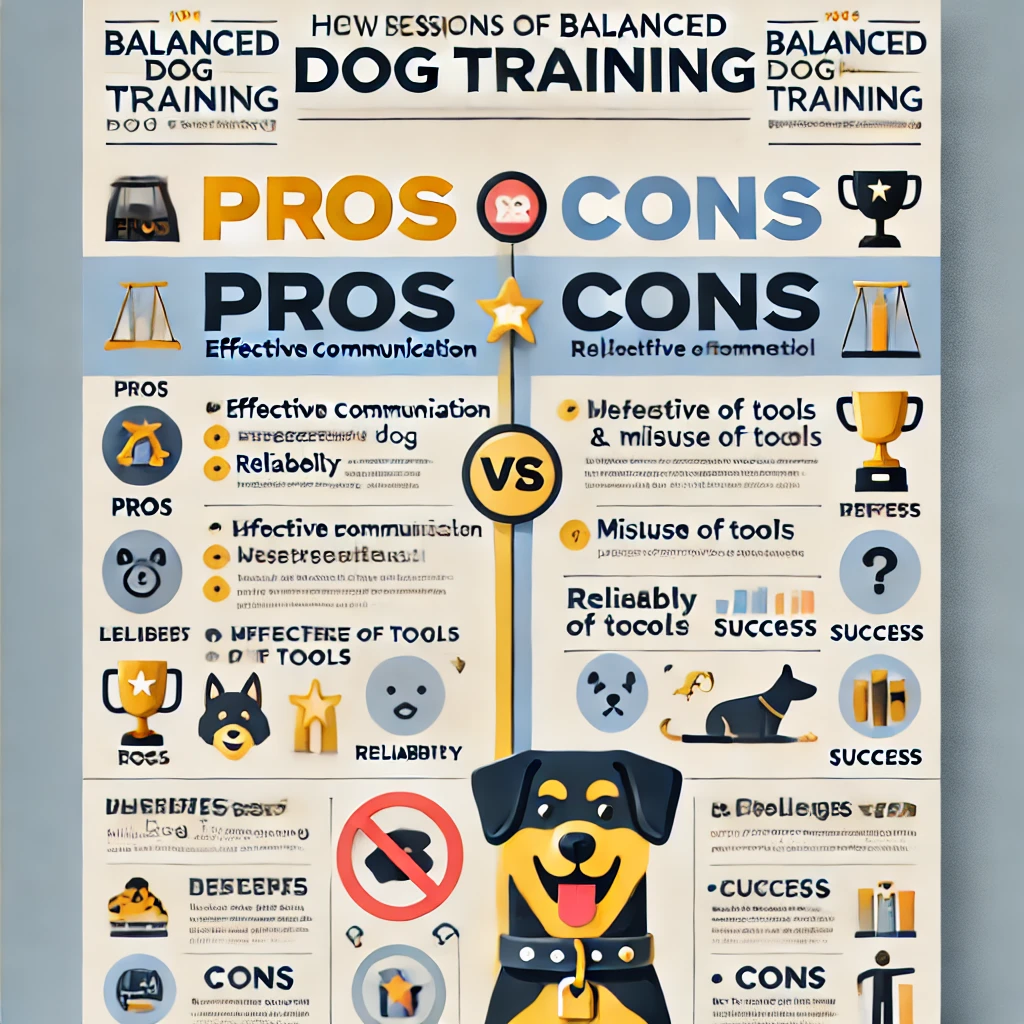Balanced Dog Training: The Pros and Cons

Balanced dog training is a popular and effective approach that combines positive reinforcement with corrections to shape desired behavior and discourage unwanted actions. This method is designed to create well-rounded, obedient dogs while ensuring clarity in communication between dog and owner.However, as with any training philosophy, balanced training has its advantages and challenges. In this article, we’ll explore the pros and cons to help you determine if this approach is right for your dog.
What Is Balanced Dog Training?
Balanced dog training uses a mix of rewards (like treats, toys, or praise) and corrections (such as leash pressure or verbal cues) to teach a dog what behaviors are desirable and which ones are not. This method emphasizes clear communication and accountability, aiming to build a trusting and respectful relationship between you and your dog.
The Pros of Balanced Dog Training
1. Effective for Most Dogs
Balanced training can work for a wide variety of dogs, regardless of age, breed, or temperament. By addressing both positive and negative behaviors, it helps create a clear learning environment.
2. Real-World Reliability
This approach prepares dogs for real-life situations by teaching them to respond to commands even in distracting environments. For example, a dog trained with balanced methods is more likely to listen when off-leash or in high-stakes scenarios.
3. Clear Communication
Balanced training emphasizes giving dogs clear expectations and boundaries, which reduces confusion and helps them understand what’s expected.
4. Builds Trust and Respect
When done correctly, balanced training fosters mutual trust. Dogs learn to look to their owner for guidance, knowing they’ll receive both fair corrections and positive reinforcement.
5. Addresses Problem Behaviors
Certain problematic behaviors, like excessive barking, leash pulling, or aggression, may not respond to purely reward-based methods. Balanced training allows owners to address these behaviors effectively.
The Cons of Balanced Dog Training
1. Requires Proper Technique
If corrections are applied improperly or inconsistently, it can confuse or stress the dog. Owners must understand how to use tools like leashes or prong collars responsibly to avoid causing harm.
2. Risk of Over-Correction
Some trainers or owners may lean too heavily on corrections, which can lead to fear or mistrust if not balanced with positive reinforcement.
3. May Not Suit All Owners
Balanced training requires commitment and a willingness to learn proper techniques. For owners who prefer purely reward-based methods, this approach may feel uncomfortable.
4. Potential Misuse of Tools
When tools like e-collars or prong collars are used improperly, they can be harmful. It’s crucial to receive guidance from an experienced trainer to ensure safe and effective use.
5. Public Misconceptions
Balanced training can sometimes be misunderstood or criticized due to misinformation about corrections. Owners may face judgment from those who favor other training methods.
Is Balanced Training Right for You?
Balanced dog training can be highly effective when done correctly, but it’s not a one-size-fits-all approach. Consider the following when deciding:
- Your Dog’s Personality: High-energy or strong-willed dogs often thrive with balanced training, as it provides structure and accountability.
- Your Goals: If you’re looking for reliable obedience in real-world settings, balanced training is an excellent choice.
- Your Willingness to Learn: Balanced training requires understanding and consistency. Partnering with an experienced trainer can make all the difference.
Final Thoughts
Balanced dog training offers a well-rounded, effective approach to raising an obedient and confident dog. By blending positive reinforcement with fair corrections, it provides clarity and prepares dogs for real-life challenges. However, success depends on proper application and an understanding of your dog’s unique needs.At Little River Country K9, I specialize in balanced training techniques that prioritize your dog’s well-being while delivering lasting results. If you’re interested in learning more or need guidance, feel free to reach out. Together, we can help your dog become the best version of themselves!